Throughout history, demons have captured the human imagination, captivating us with their malevolence and mysterious allure. In the world of art, the depiction of demons has been a subject of both fascination and fascination. Artists have sought to capture these otherworldly beings, ranging from the ethereal and awe-inspiring to the grotesque and terrifying, in their masterpieces. These famous paintings of demons have become iconic symbols, resonating with our deepest fears, desires, and the eternal struggle between good and evil.
In this article, we delve into the mesmerizing realm of 10 renowned paintings of demons. We will explore the symbolism embedded within these artworks, examining their historical context and the artist’s skillful craftsmanship in breathing life into these supernatural entities on the canvas.
The Demon Seated

Artist: Mikhail Vrubel
Year: 1580
Mikhail Vrubel, a prominent Russian painter of the late 19th century, emerged during a time when artists were exploring new and innovative approaches to the supernatural. In an era dominated by religious themes derived from the Christian church and biblical narratives, Vrubel distinguished himself by offering a more personal and believable portrayal of a demon.
Inspired by a renowned poem written by the Russian poet Lermontov, Vrubel embarked on a series of artworks, totaling around 30, that captured this enigmatic creature in various solitary outdoor settings.
Among his iconic pieces from this series, “Demon Seated,” completed in 1890, stands out as a testament to Vrubel’s artistic prowess.
The painting portrays the demon perched upon a hillside, his legs drawn close to his body, seemingly seeking solace from inner turmoil. Through the skillful use of bold and intense colors, Vrubel conveys the demon’s power and asserts its palpable existence within the artist’s perception.
Vrubel’s depiction of the demon challenges traditional artistic norms, presenting a more nuanced and personal interpretation of supernatural beings. His exploration of the demon as a subject matter reflects the artist’s desire to delve deeper into the realms of imagination and emotions, transcending conventional religious narratives.
Mikhail Vrubel’s artistic legacy endures as a testament to his bold vision and his willingness to challenge the artistic conventions of his time. Through his exploration of the demon, he paved the way for new artistic expressions and expanded the boundaries of the supernatural in art. “Demon Seated” encapsulates Vrubel’s ability to capture the essence of the supernatural in a highly evocative and thought-provoking manner.
The Last Judgement
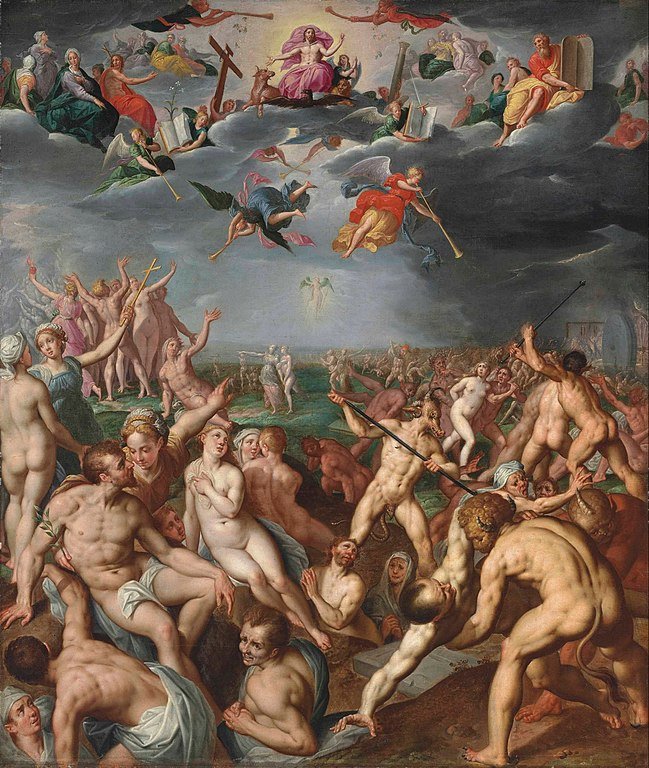
Artist: Jacob de Backer the Younger
Year: 1580
Jacob de Backer the Younger was a notable artist of the late Renaissance era in northern Europe during the 16th century. Despite his premature passing at the age of 30, he left behind an impressive artistic legacy. One of his most renowned masterpieces is a painting that brings together prominent religious figures from both the Old and New Testaments of the Christian Bible. Completed around 1580, this magnificent work is titled “The Last Judgement.”
“The Last Judgement” portrays Jesus, depicted as a divine figure, suspended above the world amidst a celestial backdrop of clouds and accompanied by a multitude of angels. The painting is divided into three distinct panels, each showcasing religious leaders of the period alongside significant figures from biblical narratives, including John the Baptist and the Virgin Mary.
Jacob de Backer’s artistic composition skillfully captures the awe-inspiring and profound nature of the final judgment. Through his brushstrokes, he invites viewers to contemplate the spiritual and moral implications of this pivotal event. The painting serves as a visual testament to de Backer’s artistic prowess and his ability to convey complex religious narratives with depth and reverence.
The Nightmare

Artist: Henry Fuseli
Year: 1781
“The Nightmare,” an oil painting created in 1781 by Swiss artist Henry Fuseli, captivates viewers with its surreal and unsettling imagery. The composition features a woman in a deep slumber, her arms sprawled beneath her, while perched upon her chest is a demonic and ape-like incubus. Fuseli’s masterful portrayal of the dreamlike and eerie atmosphere resonated strongly with audiences, resulting in its widespread popularity.
The painting delves into the realm of human experiences, specifically exploring the phenomenon known as sleep paralysis. Many individuals have reported encounters with what they describe as a “sleep paralysis demon,” an entity that manifests during episodes of sleep paralysis. Fuseli’s work serves as a symbolic representation of this haunting phenomenon, evoking feelings of infatuation, obsession, and vulnerability.
It remains uncertain whether Fuseli himself or another person had a personal encounter with sleep paralysis, serving as inspiration for this remarkable artwork. Nevertheless, “The Nightmare” showcases Fuseli’s meticulous attention to detail, as he skillfully employs chiaroscuro—a technique that juxtaposes light and dark—to convey the stark contrast between good and evil.
The Torment of Saint Anthony
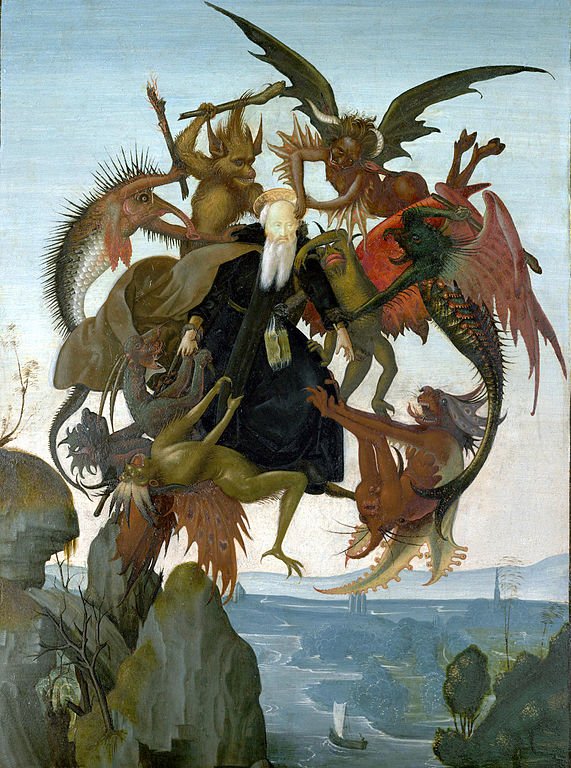
Artist: Michelangelo
Year: 1487–1488
The painting known as “The Torment of Saint Anthony” is often attributed to Michelangelo, despite the lack of concrete evidence linking it to the renowned Renaissance artist. The artwork portrays a recurring medieval theme, found in texts like the Golden Legend, depicting Saint Anthony (AD 251 – 356) enduring relentless assaults by demons in the desert, which he valiantly resists.
Interestingly, this particular composition appears to depict a later episode in the saint’s life. In the traditional narrative, St. Anthony is usually portrayed as being carried through the desert by angels, transcending earthly challenges. However, in this painting, a significant departure from convention occurs, presenting an aerial ambush by devilish figures, interrupting St. Anthony’s ascent.
While the true creator of this artwork remains uncertain, the power and intensity of the depiction capture the anguish and spiritual struggle faced by the revered saint. The composition invites contemplation on the complexities of temptation, resistance, and the eternal battle between good and evil.
Dante And Virgil
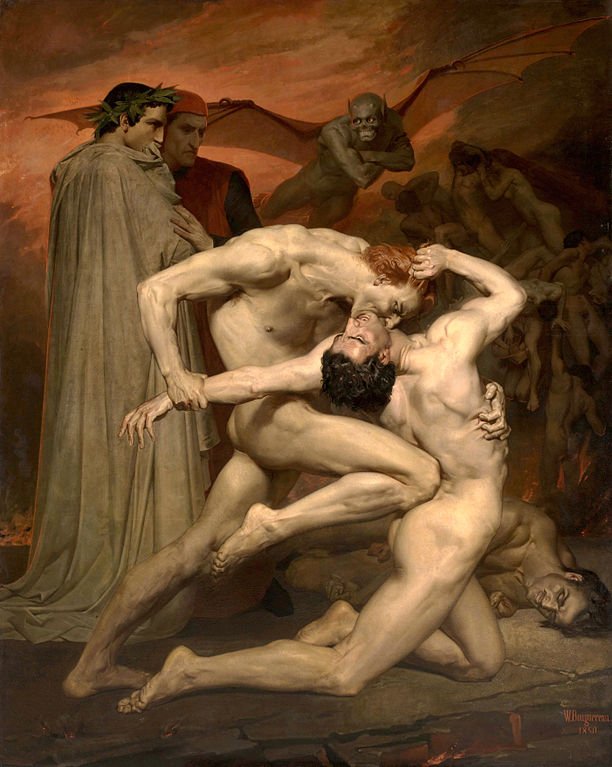
Artist: Michelangelo
Year: 1850
“Dante and Virgil” is an impressive oil-on-canvas painting created in 1850 by the French academic painter William-Adolphe Bouguereau. Inspired by Dante’s Divine Comedy, a renowned epic poem recounting a journey through the 9 Circles of Hell, Bouguereau masterfully captures a pivotal scene from this literary masterpiece.
As a prominent artist of the late 19th century, Bouguereau dedicated his talents to depicting mythological narratives, and “Dante and Virgil” stands as one of his most renowned works. The painting portrays Dante, the protagonist, standing alongside his guide, Virgil, within the depths of the Underworld. Together, they witness a ceaseless battle between two damned souls, forever locked in a tormenting struggle.
Virgil enlightens Dante about the eternal nature of this conflict, where these two individuals perpetually inflict suffering upon each other without a discernible purpose or resolution. The painting exudes remarkable attention to detail, with Bouguereau’s skillful brushwork accentuating the nude forms of the two figures. The surrounding environment, bathed in reddish hues, further enhances the intensity of the scene.
Saint Augustine and the Devil

Artist: Michael Pacher
Year: 1850
Michael Pacher, a remarkably talented German artist of the 15th century, stands out for his unique blend of Renaissance influences in his paintings. In an era when the Catholic Church thrived, Pacher ventured to incorporate new styles and practices into his artistic endeavors. His works often revolved around religious themes, portraying significant figures from that time or the period preceding his birth.
Completed around 1475, “Saint Augustine and the Devil,” captures a powerful scene where St. Augustine confronts Satan, the malevolent ruler of Hell. In the artwork, the devil menacingly presents a book, seemingly enticing St. Augustine to inscribe his name within its pages. Pacher’s portrayal of Satan deviates from previous depictions, revealing a twisted and monstrous figure, unprecedented in its representation.
The painting delves into the eternal struggle between good and evil, compelling viewers to contemplate the battle between temptation and virtue. Pacher’s audacious portrayal of Satan challenges conventional artistic norms, leaving an indelible impression on those who behold this remarkable work.
The Blessed Guillaume De Toulouse Tormented By Demons
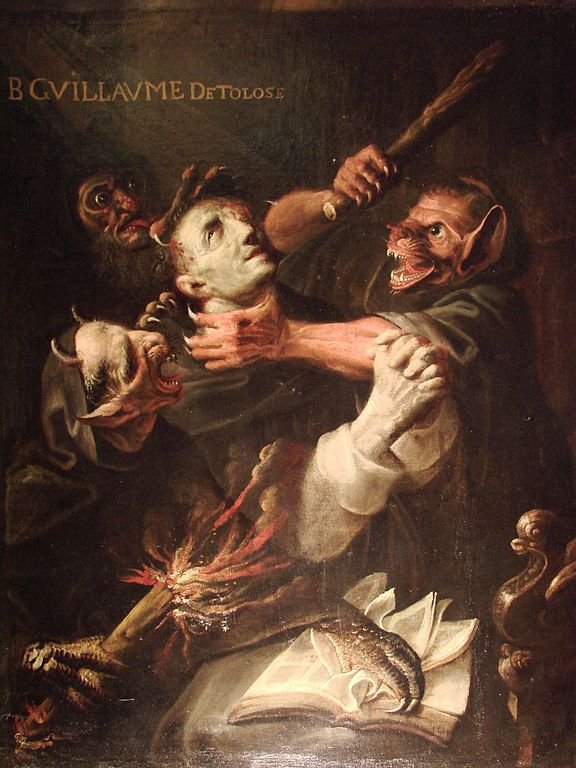
Artist: Ambroise Fredeau
Year: 1657
“The Blessed Guillaume De Toulouse Tormented By Demons” is a captivating oil painting created in 1657 by the esteemed French painter and sculptor, Ambroise Fredeau. The artwork vividly portrays Guillaume De Toulouse, also known as William of Gellone, enduring the torment inflicted upon him by three terrifying demons. This intense and evocative piece of art now finds its place in the Musée des Augustins in Toulouse, France.
Guillaume De Toulouse, a prominent historical figure, served as the second Duke of Toulouse from 790 until 811. Notably, in the year 804, he established the renowned abbey of Gellone. Recognized for his pious and noble character, Guillaume De Toulouse was canonized as a saint in 1066 by Pope Alexander II.
The painting’s composition immerses viewers in a gripping narrative, offering a glimpse into what might represent the inner struggles faced by the blessed saint, ensuring a captivating visual experience for all who look at the artwork.
Lucifer
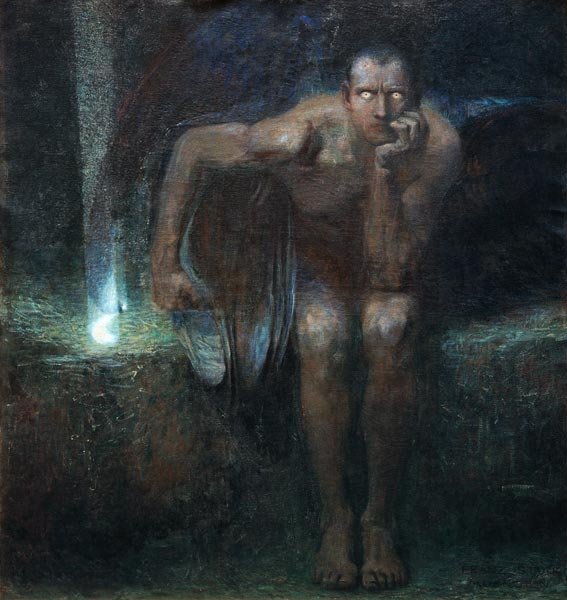
Artist: Franz Stuck
Year: 1890
Lucifer, completed in 1890 by the renowned German artist Franz Stuck, stands as a significant masterpiece within the Munich Secession movement. This painting, belonging to Stuck’s “dark monumental” period, portrays a mesmerizing representation of a “man-demon.” With profound symbolism, it captures the embodiment of evil in the form of Lucifer, a figure deeply ingrained in Christian cultures and religious traditions.
Stuck’s artwork delves into the depths of the human psyche, presenting a powerful image of Lucifer as the personification of a hostile and destructive force. The intricate brushwork and meticulous attention to detail showcase Stuck’s exceptional skill and artistic vision, evoking both awe and unease within the viewer.
The Demons Threaten Dante and Virgil

Artist: Gustave Dore
Year: 1861-1868
Gustave Dore’s illustrations of Dante’s Divine Comedy, created between 1861 and 1868, have become iconic representations of the text that continue to resonate with audiences today. Among the striking imagery that Dore brought to life, his portrayal of the Malebranche stands out. These menacing demons appear in the Inferno section of Dante’s Divine Comedy, serving as the guardians of Bolgia Five within the Eighth Circle of Hell.
The illustration portrays the culmination of the part when Dante and Virgil meet the Malebranche leader, Malacoda, who assigns a troop to guide them to the next bridge. Malacoda reveals the destroyed bridges from the earthquake at Christ’s death, providing a time reference. The troop torments a barrator, Ciampolo, who exposes Italian grafters before tricking the demons and escaping into the pitch. The deceitful and malicious Malebranche breaks their promise, forcing Dante and Virgil to flee for their safety.
Satan Calling Up His Legions

Artist: William Blake
Year: 1804
William Blake, an acclaimed English painter, and poet of the late 18th and early 19th centuries, is renowned for his memorable artworks. A prominent figure in the Romanticism movement, his paintings are characterized by distinctive coloration and symbolic imagery. One of his most famous works is “Satan Calling Up His Legions” (1804), depicting Satan atop a rocky outcrop in Hell, summoning his demons. The painting evokes a sinister atmosphere through its harsh red hues and dark undertones, symbolizing Satan’s gathering of forces for the final battle against God and His angels.
